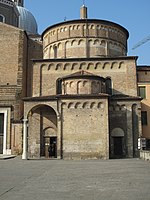Basilica del Carmine, Padua
14th-century Roman Catholic church buildings in Italy15th-century Roman Catholic church buildings in ItalyMinor basilicas in VenetoOur Lady of Mount CarmelRoman Catholic churches in Padua

The Basilica del Carmine is a 16th-century Roman Catholic church located on piazza Francesco Petrarca in Padua, region of Veneto, Italy. It was made a minor basilica in 1960 by pope John XXIII
Excerpt from the Wikipedia article Basilica del Carmine, Padua (License: CC BY-SA 3.0, Authors, Images).Basilica del Carmine, Padua
Via Carlo Leoni, Padua San Giuseppe
Geographical coordinates (GPS) Address Nearby Places Show on map
Geographical coordinates (GPS)
| Latitude | Longitude |
|---|---|
| N 45.41 ° | E 11.87 ° |
Address
Via Carlo Leoni
Via Carlo Leoni
35139 Padua, San Giuseppe
Veneto, Italy
Open on Google Maps









